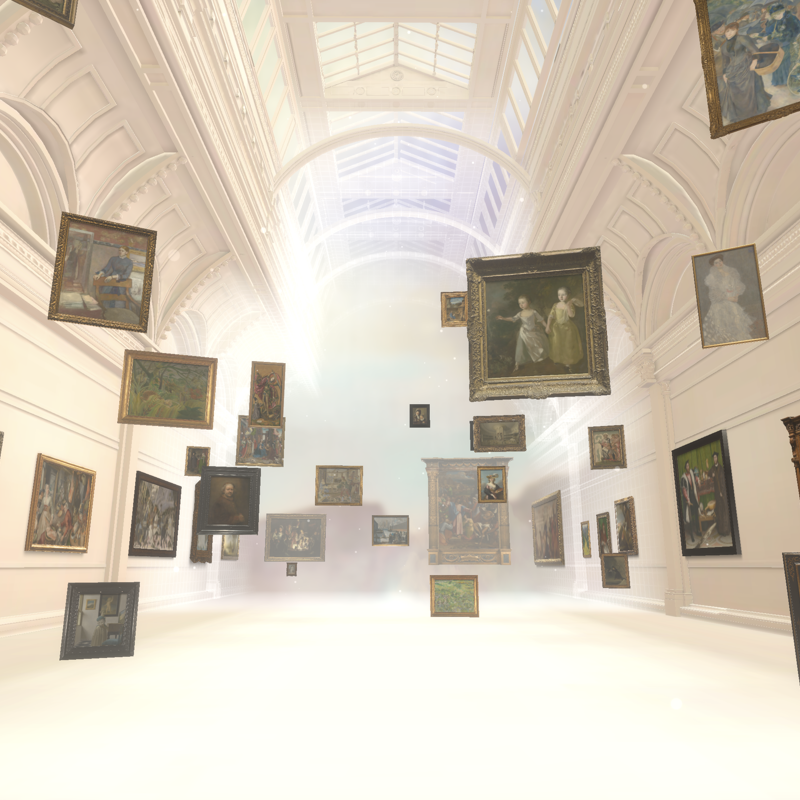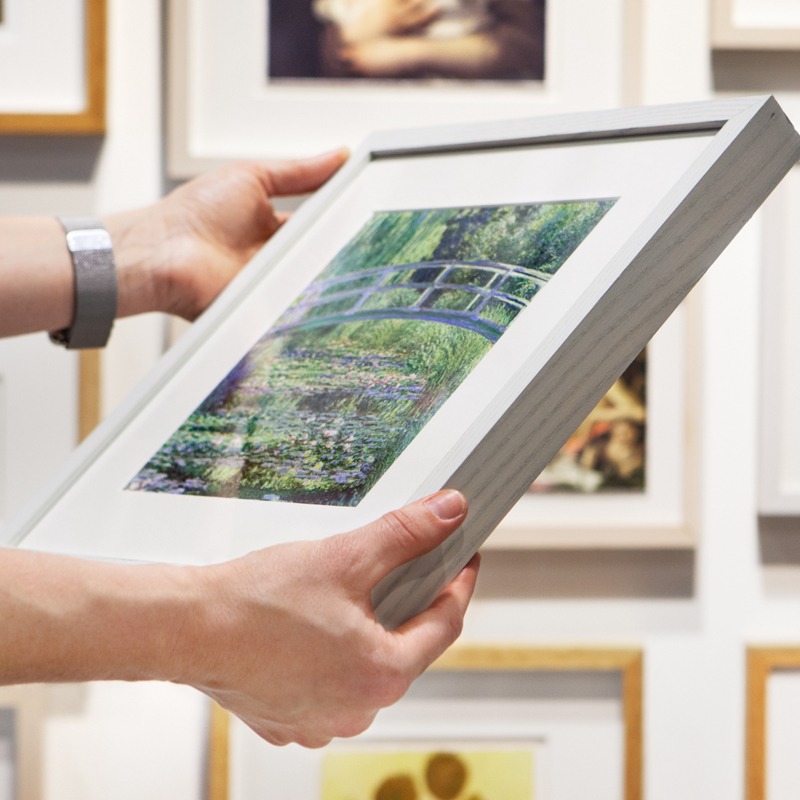Paolo Uccello, 'The Battle of San Romano', probably about 1438-40
About the work
Overview
It’s hard to follow what’s going on in this large and busy painting, partly because it’s much darker now than when it was painted. This is one of three battle scenes by Uccello showing the Florentine victory at San Romano in 1432.
The Florentine commander, Niccolò da Tolentino, rides a white charger and wears a magnificent red and gold hat. He leads a cavalry charge from the left, while at the right a knight on a white horse fights off three others.
Uccello was intensely interested in linear perspective – using lines to create an impression of three-dimensional space within a painting – which was a relatively recent discovery. Here he is clearly experimenting: the broken lances in the foreground make a formal grid-like pattern, and scattered pieces of armour are shown at various angles.
Key facts
Details
- Full title
- Niccolò Mauruzi da Tolentino at the Battle of San Romano
- Artist
- Paolo Uccello
- Artist dates
- about 1397 - 1475
- Date made
- probably about 1438-40
- Medium and support
- egg tempera with some oil on wood
- Dimensions
- 182 × 320 cm
- Acquisition credit
- Bought, 1857
- Inventory number
- NG583
- Location
- Not on display
- Collection
- Main Collection
- Frame
- 21st-century Replica Frame
Provenance
Additional information
Text extracted from the ‘Provenance’ section of the catalogue entry in Dillian Gordon, ‘National Gallery Catalogues: The Fifteenth Century Italian Paintings’, vol. 1, London 2003; for further information, see the full catalogue entry.
Bibliography
-
1878G. Vasari, Le vite de'più eccellenti pittori, scultori ed architettori: Con nuove annotazioni e commenti di Gaetano Milanesi, ed. G. Milanesi, 8 vols, Florence 1878
-
1898C. Loeser, 'Paolo Uccello', Repertorium für Kunstwissenschaft, XXI, 1898, pp. 83-94
-
1901H. Horne, 'The Battle-Piece by Paolo Uccello in the National Gallery', Monthly Review, 1901, pp. 114-38
-
1903J.A. Crowe and G.B. Cavalcaselle, A History of Painting in Italy, Umbria, Florence and Siena, from the Second to the Sixteenth Century, ed. R.L. Douglas, 2nd edn, 6 vols, London 1903
-
1903J. Ruskin, Modern Painters, eds E.T. Cook and A. Wedderburn, The Works of John Ruskin, 39 vols, London 1903
-
1927C.J. Holmes, Notes on the Science of Picture Making, London 1927
-
1932G. Gronau, 'Zu Paolo Uccellos Schlachtenbildern', Pantheon, IX, 1932
-
1934G. Pudelko, 'The Early Works of Paolo Uccello', Art Bulletin, XVI/3, 1934, pp. 231-59
-
1938M. Salmi, Paolo Uccello, Andrea del Castagno, Domenico Veneziano, Milan 1938
-
1939W. Boeck, Paolo Uccello: Der Florentiner Meister und sein Werk, Berlin 1939
-
1944J. Pope-Hennessy, Paolo Uccello: The Rout of San Romano in the National Gallery, London, London 1944
-
1946M. Pittaluga, Paolo Uccello, Rome 1946
-
1946E. Somaré, Paolo Uccello, Milan 1946
-
1950J. Pope-Hennessy, The Complete Work of Paolo Uccello, London 1950
-
1951Davies, Martin, National Gallery Catalogues: The Earlier Italian Schools, London 1951
-
1954U. Baldini, 'Restauri di Dipinti Fiorentini in occasione della mostra di Quattro Mestri del Rinascimento', Bollettino d'arte, XXXIX/4, 1954, pp. 221-40
-
1956E. Micheletti, Paolo Uccello, Novara 1956
-
1957E. Sindona, Paolo Uccello, Milan 1957
-
1957E. Newton, 'Round the National Gallery. Niccolo da Tolentino at the Battle of San Romano by Paolo Uccello (c.1397-1475)', Art News and Review, 1957
-
1957A. Parronchi, 'Le fonti di Paolo Uccello: I perspettivi passati', Paragone, LXXXIX/8, 1957, pp. 3-33
-
1958D. Gioseffi, 'Complementi di prospettiva', Critica d'arte, V/25-26, 1958, pp. 102-49
-
1961M. Davies, The Earlier Italian Schools, 2nd edn, London 1961
-
1969W.A. Bulst, 'Die ursprüngliche innere Anfteilung des Palazzo Medici in Florenz', Mitteilungen des Kunsthistorischen Institutes in Florenz, XIV/4, 1969, pp. 369-92
-
1970L.G. Boccia, 'Le armature di Paolo Uccello', L'arte, III, 1970, pp. 55-91
-
1972E. Sindona, 'Introduzione alla poetica di Paolo Uccello. Relazione tra prospettiva e pensiero teoretico', L'arte, XVII, 1972, pp. 7-100
-
1974A. Parronchi, Paolo Uccello, Bologna 1974
-
1974'The Rout of San Romano', Horizon, 1974
-
1974A. Parronchi, 'Una data per le battaglie', La nazione, 1974
-
1975S. Meloni Trkulja, 'Vicende ignorate della "Battaglia di San Romano"', Paragone, CCCIX/26, 1975, pp. 108-11
-
1978G. Griffiths, 'The Political Significance of Uccello's Battle of San Romano', Journal of the Warburg and Courtauld Institutes, LI, 1978, pp. 313-6
-
1981M.L. Testi Cristiani, 'Panoramica a volo d'Uccello: La battaglia di San Romano', Critica d'arte, XLVI, 1981, pp. 3-47
-
1982R.V. Wells, 'Uccello's "Rout of San Romano"', History Today, 1982, pp. 44-6
-
1984R. Starn and L. Partridge, 'Representing War in the Renaissance: The Shield of Paolo Uccello', Representations, V, 1984, pp. 33-65
-
1985J.N. O'Grady, 'An Uccello Enigma', Gazette des beaux-arts, CV, 1985, pp. 99-103
-
1986Davies, Martin, National Gallery Catalogues: The Earlier Italian Schools, revised edn, London 1986
-
1986D. Abse and J. Abse, Voices in the Gallery: Poems and Pictures, London 1986
-
1987J. Ruskin, Modern Painters, ed. D. Barrie, New York 1987
-
1988A. Conti, Storia del restauro e della conservazione delle opere d'arte, Milan 1988
-
1989P. Joannides, 'Paolo Uccello's "Rout of San Romano": A New Observation', The Burlington Magazine, CXXXI/1032, 1989, pp. 214-6
-
1990W.A. Bulst, 'Uso e trasformazione del palazzo mediceo fino ai Riccardi', in Il Palazzo Medici di Firenze, Florence 1990, pp. 98-124
-
1991J. Dunkerton et al., Giotto to Dürer: Early Renaissance Painting in the National Gallery, New Haven 1991
-
1991V. Gebhardt, Paolo Uccellos 'Schlacht von san Romano': Ein Beitrag zur Kunst der Medici in Florenz, Florence 1991
-
1991A. Paolieri, Paolo Uccello, Domenico Veneziano, Andrea del Castagno, Florence 1991
-
1991A. Padoa Rizzo, Paolo Uccello: Catalogo completo, Florence 1991
-
1991V. Gebhardt, 'Some Problems in the Reconstruction of Uccello's "Rout of San Romano" Cycle', The Burlington Magazine, CXXXIII/1056, 1991, pp. 179-85
-
1991M. Kemp and A. Massing, 'Paolo Uccello's "Hunt in the Forest"', The Burlington Magazine, CXXXIII/1056, 1991, pp. 164-78
-
1991National Gallery, 'John Carey's Picture Choice', National Gallery News, 1991
-
1992F. Borsi and S. Borsi, Paolo Uccello, Paris 1992
-
1992M.B. Hall, Colour and Meaning: Practice and Theory in Renaissance Painting, Cambridge 1992
-
1992P. Joannides, 'Letter, in Response to Article by V. Gebhardt', The Burlington Magazine, CXXXIV/1069, 1992
-
1992L.G. Boccia, 'Ancient Italian Pieces in the Kienbusch Collection', in C. Blair, Studies in European Arms and Armour, Philadelphia 1992, pp. 33-65
-
1993J.H. Beck and M. Daley, Art Restoration: The Culture, the Business and the Scandal, London 1993
-
1993D. Hope, 'My Personal Choice: Doris Lessing Selects Paolo Uccello's Battle of San Romano', The Scotsman, 1993
-
1993W.J. Wegener, '"That the Practice of Arms Is Most Excellent Declare the Statues of Valiant Men": The Luccan War and Florentine Political Ideology in Paintings by Uccello and Castagno', Renaissance Studies, VII/2, 1993, pp. 129-67
-
1994P. Roccasecca, 'Paolo Uccello: I dipinti di battaglia', in Da Aristotele alla Cina. Sei Saggi di storia dell'arte universale, Rome 1994, pp. 35-70
-
1995V. Gebhardt, Paolo Uccello: Die Schlacht von San Romano, Frankfurt am Main 1995
-
1996J. Bloedé, Paolo Uccello et la représentation du mouvement: Regards sur la Bataille de San Romano, Paris 1996
-
1997P. Roccasecca, Paolo Uccello. Le Battaglie, Milan 1997
-
1998L. Melli, 'Nuove indagini sui disegni di Paolo Uccello Agli Uffizi: Disegno sottostante, tecnica, funzione', Mitteilungen des Kunsthistorischen Institutes in Florenz, XLII/1, 1998, pp. 1-39
-
1999R. Duits, 'Figured Riches: The Value of Gold Brocades in Fifteenth-Century Florentine Painting', Journal of the Warburg and Courtauld Institutes, LXII, 1999, pp. 60-92
-
1999F. Zeri, 'Paolo Uccello: Battaglia di San Romano', in M. Dolcetta (ed.), Federico Zeri: Un velo di silenzio, Florence 1999, pp. 48-53
-
2001
C. Baker and T. Henry, The National Gallery: Complete Illustrated Catalogue, London 2001
-
2001F. Caglioti, 'Nouveautés sur la "Bataille de San Romano" de Paolo Uccello', Revue du Louvre, LI/4, 2001, pp. 37-54
-
2001A. Roy and D. Gordon, 'Uccello's "Battle of San Romano"', National Gallery Technical Bulletin, XXII, 2001, pp. 4-17
-
2002M. Spring and R. Grout, 'The Blackening of Vermilion: An Analytical Study of the Process in Paintings', National Gallery Technical Bulletin, XXIII, 2002
-
2003Gordon, Dillian, National Gallery Catalogues: The Fifteenth Century Italian Paintings, 1, London 2003
-
2005M. Kemp and A. Criminisi, 'Paolo Uccello's "Rout of San Romano": Order from Chaos', New, I, 2005, pp. 84-9
-
2005P. Pertici, 'A proposito delle battaglie di Paolo Uccello', Bollettino senese di storia patria, III, 2005, pp. 311-8
-
2005P. Roccasecca, 'La Rotta di San Romano e la Rotta di Niccolò Piccinino. Paolo Uccello e i Bartolini: Le ragioni di una commissione attraverso I'iconografia delle battaglie', Bulletin de l'Association des Historiens de l'Art Italien, II, 2005, pp. 5-21
-
2006J. Harris, 'Whose Perspective? Andrea del Castagno, Paolo Uccello and the Patron's Point of View', Immediations, I/3, 2006, pp. 4-23
-
2006J. Miller and L. Taylor-Mitchell, 'Donatello's "S. Rossore" the Battle of San Romano and the Church of Ognissanti', The Burlington Magazine, CXLVIII/1243, 2006, pp. 685-8
-
2006Ajmar-Wollheim and F. Denniss (eds), At Home in Renaissance Italy (exh. cat. Victoria and Albert Museum, 5 October 2006 - 7 January 2007), London 2006
-
2007S. Bibby, 'Changing Perspectives: The Florentine Histories of Uccello's "Battle of San Romano" Panels', Object, X, 2007, pp. 5-24
Frame
This walnut inlay frame was made at the Gallery in 2024. It is decorated with boxwood cutouts that form a guilloche surface pattern. The intricate design was inspired by the wooden inlays of the sacristy cupboards in Santa Maria del Fiore (the Duomo) in Florence.
The series of three paintings, which all show episodes from the Battle of San Romano, were originally set under a vaulted ceiling and had arched tops. All the contemporary framings follow the later rectangular shape of the paintings. Of the two scenes not in the National Gallery’s collection, one is housed in the Galleria degli Uffizi, Florence, where it is held in a metal structure. The other is in the Musée du Louvre, Paris, framed in a fully carved and gilt Italian reverse moulding.
About this record
If you know more about this painting or have spotted an error, please contact us. Please note that exhibition histories are listed from 2009 onwards. Bibliographies may not be complete; more comprehensive information is available in the National Gallery Library.



